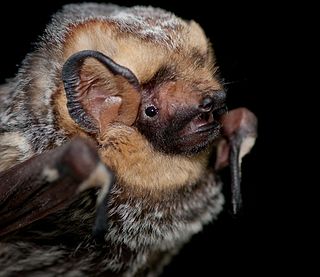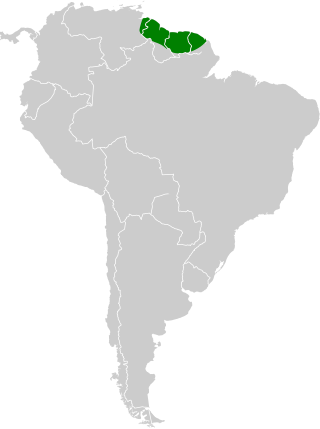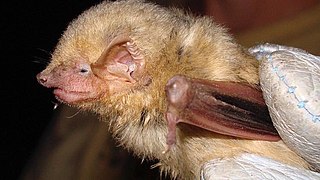
Lasiurus is a genus of bats in the family Vespertilionidae. Its members are known as hairy-tailed bats or red bats.

The southern red bat is a species of microbat found in South America.

The hoary bat is a species of bat in the vesper bat family, Vespertilionidae. It lives throughout most of North America.

The southern yellow bat is a species of vesper bat that belongs to suborder microchiroptera (microbat) in the family Vespertilionidae. It is native to South, North and Central America, from the Rio Grande Valley of Texas in the United States to Argentina.

The big red bat is a species of vesper bat from South and Central America.

The eastern red bat is a species of microbat in the family Vespertilionidae. Eastern red bats are widespread across eastern North America, with additional records in Bermuda.

The Hawaiian hoary bat, also known as ʻōpeʻapeʻa, is a species of bat endemic to the islands of Hawaiʻi. Whereas the mainland hoary bat is found throughout North America, the Hawaiian hoary bat is distributed only among the major volcanic islands of Hawaiʻi, making it the only extant and native terrestrial mammal in the state; although some studies also posit that the mainland hoary bat lives in sympatry on the Hawaiian Islands alongside the Hawaiian hoary bat, this has been disputed. The Hawaiian hoary bat was officially named the state land mammal of Hawaiʻi in 2015. It is a federally listed endangered taxon of the United States.

Lasiurus atratus, the greater red bat, is a species of vesper bat. It is found in Guyana, Venezuela, French Guiana and Suriname.
The Tacarcuna bat is a species of vesper bat. It is found in Costa Rica, Panama and possibly Colombia.

The western yellow bat is a species of vesper bat found in Mexico and the southwestern United States. This species roosts in trees such as Populus fremontii, Platanus wrightii, and Quercus arizonica. If available, the western yellow bat will use the dead fronds that encircle palm trees as a roosting site.
The Jamaican red bat is a species of vesper bat. It is endemic to Jamaica.

The cinnamon red bat is a species of bat in the family Vespertilionidae. It was first described from a specimen that had been collected in Chile. For more than one hundred years after its initial description, it was largely considered a synonym of the eastern red bat. From the 1980s onward, it was frequently recognized as distinct from the eastern red bat due to its fur coloration and differences in range. It has deep red fur, lacking white "frosting" on the tips of individual hairs seen in other members of Lasiurus. It has a forearm length of 39–42 mm (1.5–1.7 in) and a weight of 9.5–11.0 g (0.34–0.39 oz).
The Cuban yellow bat is a species of bat from the family Vespertilioninae. It was previously included as a subspecies of the northern yellow bat, a species that has a similar ecology and biology. The species is endemic to Cuba, specifically the Las Villas Province in Cienfuegos, and it is listed under the IUCN Red List as vulnerable due to its ongoing population reduction and relatively small geographic range.
The minor red bat is a species of bat from the family Vespertilioninae. It is found in the Bahamas, Hispaniola, and Puerto Rico in the Caribbean, though there are only six known individuals in the latter.
Pfeiffer's red bat is a species of bat from the family Vespertilioninae and is endemic to Cuba. It is listed as Near Threatened by the IUCN Red List due to a significant population decline, caused by human population density on its endemic island, habitat conversion, and hurricanes. The species is likely insectivorous; fecal matter samples from a single bat contained only beetles. It may be a subspecies of the Seminole bat.

The saline red bat is a species of bat from the family Vespertilionidae. It was formerly included as a subspecies or a synonym of the eastern red bat and the desert red bat, but is distinct. The species is present in Argentina, and its type locality has been found in the city of Cruz del Eje in the Córdoba Province.

Aeorestes is a genus or subgenus of vesper bat commonly known as the hoary bats. As a genus, it includes species that were formerly included in the genus Lasiurus.

Dasypterus is a genus of or subgenus of vesper bat. As a genus, it includes species that were formerly in the genus Lasiurus. Collectively, members of Dasypterus are referred to as the yellow bats.

Lasiurini is a tribe of bats in the family Vespertilionidae. It contains three genera of bats found in the Americas. All three genera were previously considered one genus, Lasiurus, but have since been split from one another. However, the validity of this split is still debated.











